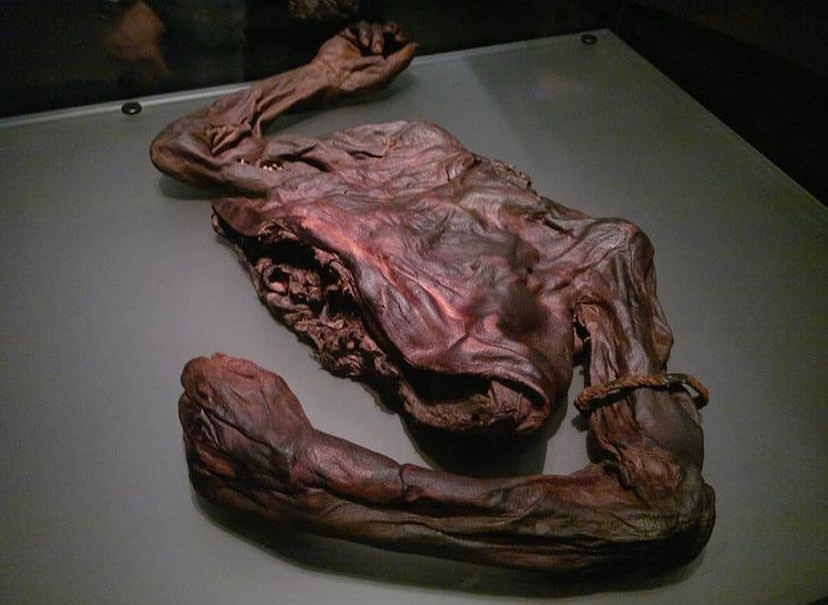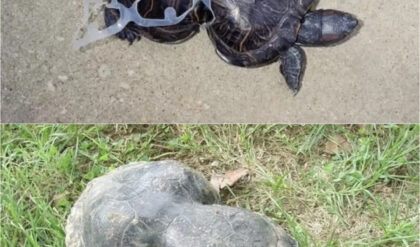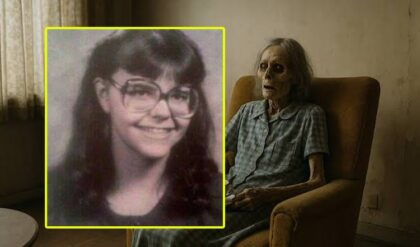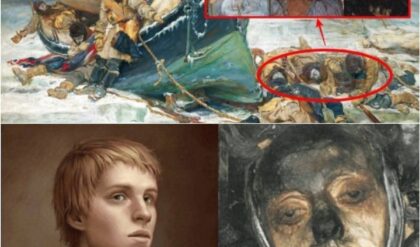What if your final bite—simple wheat and buttermilk—held the key to a 2,000-year-old royal murder? Unearthed from an Irish bog in 2003, his torso whispered secrets of elite feasts, brutal betrayal, and nipples sliced as a king’s curse.
Old Croghan Man: 6’6″ Iron Age giant, manicured nails hiding a meat-lovers life… until that humble last meal. Decapitated, halved, drowned in peat—rejected ruler or fertility sacrifice? His preserved gut spilled the truth, but the real horror? He fought back.
One ancient body, endless chills. Dive into the bog’s bloodiest riddle before it swallows you whole:

On a drizzly June morning in 2003, as peat cutters sliced through the sodden earth of a drainage ditch near Croghan Hill in County Offaly, Ireland, their machine snagged on something unyielding. At first, they thought it was a root or a discarded tool—common debris in the boglands that have sustained Irish agriculture for millennia. But as the muck parted, a human arm emerged, severed at the shoulder, its skin leathery and intact, nails polished like a modern executive’s. Further probing revealed a torso: broad, muscled, and grotesquely mutilated, with deep gashes under the nipples and a fatal stab wound piercing the chest. No head, no legs—just the core of a man who had lain hidden for over 2,000 years. Dubbed “Old Croghan Man” after the nearby hill, this Iron Age bog body wasn’t just a relic; he was a snapshot of Celtic power, privilege, and peril. Forensic analysis of his remarkably preserved stomach contents—grains of wheat mingled with the curdled remnants of buttermilk—offered a haunting glimpse into his final hours, contrasting sharply with the elite, meat-heavy diet he’d enjoyed for months prior. His discovery, alongside the Clonycavan Man just three months earlier, ignited the Bog Bodies Research Project and reshaped our understanding of ancient Ireland’s ritual violence.
The Irish bogs—vast, waterlogged expanses covering 1.1 million hectares, or 17% of the island’s land—are nature’s accidental vaults. Formed after the last Ice Age from sphagnum moss that choked prehistoric lakes, these acidic, anaerobic environments halt decay like a cosmic pause button. Tannins from the peat tan flesh like leather, while cold temperatures and low oxygen starve bacteria. Over 100 human bog bodies have surfaced across northern Europe since the 18th century, from Denmark’s Tollund Man (1950) to Germany’s Yde Girl (1897). But Ireland’s yield 17, including Old Croghan, making it a hotspot for these “wetland mummies.” The 2003 finds were serendipitous: Clonycavan Man, unearthed in a Meath peat factory in March, sported imported hair gel from the Alps; Croghan followed in June, during routine turf harvesting for fuel and horticulture. Both dated to the Iron Age (c. 900 BCE–400 CE), a era when Celtic tribes dominated with hillforts, torcs of twisted gold, and druidic rites shrouded in mist.
Croghan Hill, rising 793 feet like a sentinel over the Bog of Allen, was no random gravesite. Known in Gaelic as Cnoc Gréine (“Hill of the Sun”), it was a ceremonial hub for the Heremon dynasty, one of Ireland’s ancient provincial kingships. Radiocarbon dating placed Old Croghan’s death between 362 and 175 BCE, smack in the La Tène period of Celtic artistry—think intricate La Tène spirals on bronze mirrors and sword hilts. At 25–30 years old and 6 feet 6 inches tall (1.98 meters)—towering over the era’s average 5-foot-5 stature—he was a physical anomaly, his frame honed not by drudgery but privilege. Manicured fingernails, free of calluses, hinted at a life of leisure: no plow or sword hilt scarred his hands. Stable isotope analysis of his hair and nails revealed a diet rich in animal protein—beef, pork, venison—for the final four months, a luxury afforded only to tribal elites in a society where commoners subsisted on barley porridge and wild berries. Yet his gut told a different tale: the last meal, preserved in the bog’s chill, consisted of wild wheat grains and buttermilk, a humble dairy-cereal sludge that might have been a ritual offering before execution.
This dietary dissonance fueled speculation. Was the buttermilk-wheat a deliberate “peasant’s farewell,” stripping him of status? Or a fertility rite, invoking bountiful harvests of grain and milk from the goddess Tailtiu, after whom the nearby ancient festival of Lughnasadh is named? Scars on his lungs suggested chronic pleurisy, perhaps from a winter cough, but he was robust at death—no signs of famine or toil. Hazelnuts in his colon hinted at autumn timing, aligning with Samhain, the Celtic New Year when veils between worlds thinned and sacrifices peaked. But the violence? Brutal and symbolic. A hazelwood pin through his arm—perhaps binding a defensive wound—showed he fought back. His throat was slit post-decapitation, body halved at the pelvis with a sharp blade, likely a sickle or sword. Most chilling: deep cuts beneath each nipple, as if symbolically “unmaking” kingship. In ancient Irish lore, vassals swore fealty by suckling a ruler’s nipples, a gesture of maternal loyalty. Mutilating them declared him a “failed king,” unfit to lead.
Eamonn Kelly, keeper of Irish Antiquities at the National Museum of Ireland, spearheaded the theory: Old Croghan was a deposed chieftain, ritually slain to avert tribal calamity. Buried straddling the Eske River—turf on one side (fertility), water on the other (underworld)—he marked a boundary, his high status ensuring the gods took notice. This echoed broader Celtic practices: bog bodies like Denmark’s Borremose Man (c. 700 BCE) show triple deaths—strangulation, throat-cutting, bludgeoning—as overkill for the divine. Genetic studies, using ancient DNA from his femur, peg him as Y-chromosome haplogroup R1b, common in modern Irish men, suggesting deep indigenous roots. Pollen in his peat layers confirmed a landscape of oak woodlands and rye fields, dotted with roundhouses and cattle herds—the Iron Age economy of pastoral nomads who traded amber with Vikings centuries later.
The 2003 discoveries weren’t isolated. The Bog Bodies Project, launched by the National Museum with 35 experts from forensics to mycology, dissected both Croghan and Clonycavan over two years. Clonycavan, shorter at 5’2″ with spiked hair greased by imported pomade, sported a similar nipple gash—perhaps a “twin execution” in the same tribal feud. CT scans revealed no defensive fractures on Croghan beyond the arm, implying ambush. His skin, tanned to mahogany, bore no tattoos, unlike some bog kin, but faint surgical scars suggested ritual scarring or healing from a prior duel. Entomological traces—beetle larvae in his wounds—dated the kill to months before submersion, the body perhaps displayed as a warning before bog burial.
Croghan’s unearthing rippled through Ireland’s cultural psyche. In a nation where bogs still yield butter churns from the Bronze Age—edible after 3,000 years—the find evoked The Secret of Roan Inish folklore, where peat hides selkies and saints. Media frenzy dubbed him “Ireland’s Giant,” with The Irish Times front-paging nail clippings as “royal evidence.” Public exhibits at the National Museum’s Kingship and Sacrifice gallery, opened in 2007, drew 500,000 visitors by 2010, blending replicas with the real torso under climate-controlled glass. Ethical debates ensued: Should he be reburied, like some UK finds, or displayed as education? Druids petitioned for repatriation to the bog; scientists countered with preservation tech—silica gels and nitrogen chambers—to halt further decay.
Broader implications? Old Croghan humanized the Celts, often romanticized as harp-strumming bards. He revealed a stratified society: elites feasting on roast boar while serfs toiled, druids wielding mistletoe knives for “triple deaths.” Climate data from his pollen—milder winters than today’s—hints at a “Roman Warm Period” enabling dairy booms, buttermilk’s sour tang a staple in crannogs. Nutritionally, his last meal underscores ritual inversion: luxury to pauper’s gruel, mirroring Greek hubris tales. Modern parallels? Forensic gastronomy now aids cold cases, analyzing stomach acid pH for time-of-death; Croghan’s wheat kernels helped calibrate bog chronologies.
In 2023, a €2 million grant funded non-invasive scans, revealing micro-fractures from a possible fall—did he tumble from Croghan’s inauguration stone? Descendant searches via R1b lineages yield no claimants, but genetic tourism booms: punters swab for Celtic roots. Pop culture nods abound—Vikings nods to bog kings, while a 2024 RTÉ docuseries, Bog Kings: Blood and Buttermilk, reenacted his rite with hazel pins and throat slits.
Yet for all science’s sleuthing, mysteries linger. Who wielded the blade? A rival tanist, or druidic decree? His nipples—postmortem insult or pre-death torment? As curator Ned Kelly mused in a 2018 Archaeology interview, “He was no victim; he was a giant among men, slain because he loomed too large.” Today, in Dublin’s hushed halls, Old Croghan’s torso gleams under spotlights, wheat-digest paused eternally. A king dethroned, his buttermilk breath a whisper: In Iron Age Ireland, power’s price was paid in peat and precision. The bog gave him back, but keeps his head.





